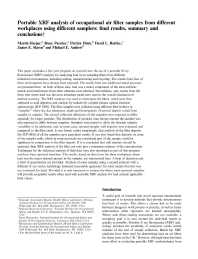Mining Publication: Portable XRF Analysis of Occupational Air Filter Samples from Different Workplaces Using Different Samplers: Final Results, Summary and Conclusions
Original creation date: November 2007
This paper concludes a five-year program on research into the use of a portable X-ray fluorescence (XRF) analyzer for analyzing lead in air sampling filters from different industrial environments, including mining, manufacturing and recycling. The results from four of these environments have already been reported. The results from two additional metal processes are presented here. At both of these sites, lead was a minor component of the total airborne metals and interferences from other elements were minimal. Nevertheless, only results from the three sites where lead was the most abundant metal were used in the overall calculation of method accuracy. The XRF analyzer was used to interrogate the filters, which were then subjected to acid digestion and analysis by inductively-coupled plasma optical-emission spectroscopy (ICP-OES). The filter samples were collected using different filter-holders or samplers where the size (diameter), depth and homogeneity of aerosol deposit varied from sampler to sampler. The aerosol collection efficiencies of the samplers were expected to differ, especially for larger particles. The distribution of particles once having entered the sampler was also expected to differ between samplers. Samplers were paired to allow the between-sampler variability to be addressed, and, in some cases, internal sampler wall deposits were evaluated and compared to the filter catch. It was found, rather surprisingly, that analysis of the filter deposits (by ICP-OES) of all the samplers gave equivalent results. It was also found that deposits on some of the sampler walls, which in some protocols are considered part of the sample, could be significant in comparison to the filter deposit. If it is concluded that wall-deposits should be analyzed, then XRF analysis of the filter can only give a minimum estimate of the concentration. Techniques for the statistical analysis of field data were also developed as part of this program and have been reported elsewhere. The results, based on data from the three workplaces where lead was the major element present in the samples, are summarized here. A limit of detection and a limit of quantitation are provided. Analysis of some samples using a second analyzer with a different X-ray source technology indicated reasonable agreement for some metals (but this was not evaluated for lead). Provided it is only necessary to analyze the filters, most personal samplers will provide acceptable results when used with portable XRF analysis for lead around applicable limit values.
Authors: M Harper, B Pacolay, PJ Hintz, DL Bartley, JE Slaven, ME Andrew
Peer Reviewed Journal Article - November 2007
NIOSHTIC2 Number: 20032866
J Environ Monit 2007 Nov; 9(11):1263-1270
See Also
- Characterizing Exposures to Airborne Metals and Nanoparticle Emissions in a Refinery
- Elastic and Shear Moduli of Coal Measure Rocks Derived from Basic Well Logs Using Fractal Statistics and Radial Basis Functions
- A Handheld Electrostatic Precipitator for Sampling Airborne Particles and Nanoparticles
- Measuring Mining Safety with Injury Statistics: Lost workdays as Indicators of Risk
- Practical Risk Assessment Guidelines for Identifying, Assessing, and Mitigating Stored Energy Hazards in Underground Coal Mines During and After a Mine Emergency
- Rock Dusting Considerations in Underground Coal Mines
- SPONCOM - A Computer Program for the Prediction of the Spontaneous Combustion Potential of an Underground Coal Mine
- SponCom - Spontaneous Combustion Assessment Software - 2.0
- Technology News 545 - NIOSH Updates Spontaneous Combustion Assessment Software
- Workplace Aerosol Measurement
- Content source: National Institute for Occupational Safety and Health, Mining Program


 ShareCompartir
ShareCompartir
